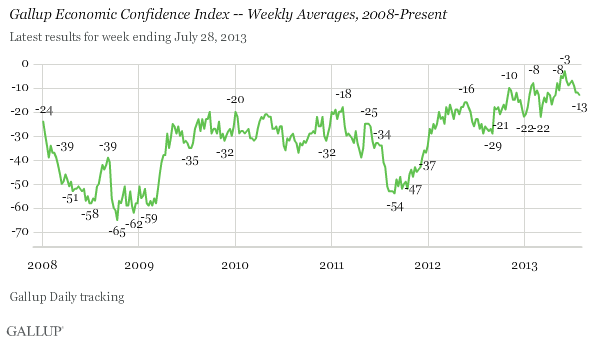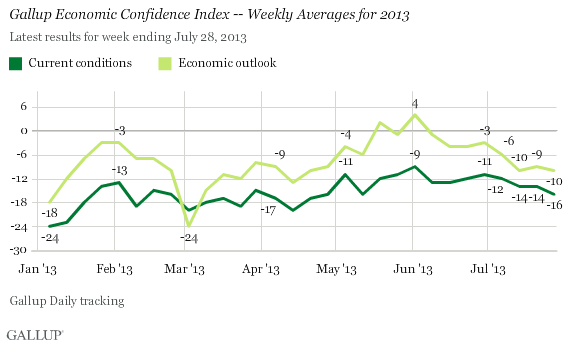WASHINGTON, D.C. -- Even as the U.S. stock market continues to rise, Americans' confidence in the economy has dropped to its lowest level since late April. Gallup's Economic Confidence Index registered -13 for the week ending July 28. This is essentially unchanged from -12 during the prior two weeks, but is 10 points lower than it was in early June. Still, consumers' confidence remains higher than it was in early March, after automatic federal budget cuts took effect.

While Americans' confidence has generally retreated since early June, from a longer-term perspective, the current index score is still one of the best Gallup has measured since January 2008.
Americans' confidence in the economy sank during the global economic crisis, with the index averaging -48 for all of 2008. However, consumers' confidence improved in 2009 and 2010, with averages of -35 and -28, respectively. Confidence slipped in 2011 to -37, partly due to a sharp drop in the summer of that year during an intense political debate over raising the debt ceiling, and Standard & Poor's subsequent downgrading of the U.S. credit rating. Confidence rebounded in 2012, averaging -21, despite slipping toward the end of the year as lawmakers in Washington tried to avert the "fiscal cliff" measures.
The Index has averaged -12 in 2013 to date, which indicates that Americans have been more confident in the economy so far this year than they were over the previous five years, although they remain more negative than positive about the U.S. economy in an absolute sense.
The index has a theoretical maximum value of +100 and a theoretical minimum of -100. Values above zero indicate that Americans have net-positive views of the economy; values below zero indicate net-negative views.

Americans' Views of Current Conditions and Their Outlook Have Worsened Since June
Gallup's Economic Confidence Index is based on Americans' responses to two questions asking them to rate economic conditions in the country today, and whether they think economic conditions are getting better or worse. Both index components held steady last week, but have declined substantially since early June. Americans' economic outlook has worsened more than their ratings of current economic conditions.
Consumers' net economic outlook rating was -10 last week, with 42% saying the economy is "getting better" and 52% saying it is "getting worse." This rating is essentially unchanged from -9 from the prior week, but is 14 points lower than in early June.
Americans' net rating of current economic conditions was -16 last week, representing 19% who say the economy is "excellent" or "good" and 35% who say it is "poor." This rating is on par with -14 from the prior week, but is the lowest since early May. Consumers' perceptions of current conditions have fallen by seven points since early June.

Bottom Line
Although the Dow Jones industrial average registered its fifth consecutive week of gains, Americans' confidence in the economy has slipped over that same time period. Gallup's Economic Confidence Index reached new weekly highs this year as U.S. stock prices soared. However, stock market gains no longer seem to be enough to keep economic confidence headed upward in the broader context of weak economic growth, a stubborn job market, rising gas prices, and mixed signals about the housing market.
While all eyes on Wall Street will be focused on new U.S. economic data -- including the Bureau of Labor Statistics' monthly jobs report -- that will be released this week, it remains to be seen whether these numbers will affect Americans' overall confidence in the economy.
Gallup.com reports results from these indexes in daily, weekly, and monthly averages and in Gallup.com stories. Complete trend data are always available to view and export in the following charts:
Daily: Employment, Economic Confidence, Job Creation, Consumer Spending
Weekly: Employment, Economic Confidence, Job Creation, Consumer Spending
Read more about Gallup's economic measures.
View our economic release schedule.
Survey Methods
Results for this Gallup poll are based on telephone interviews conducted July 22-28, 2013, on the Gallup Daily tracking survey, with a random sample of 3,566 adults, aged 18 and older, living in all 50 U.S. states and the District of Columbia.
For results based on the total sample of national adults, one can say with 95% confidence that the margin of sampling error is ±2 percentage points.
for this Gallup poll are based on telephone interviews conducted MM DD, 2013, with a random sample of x,xxx adults, aged 18 and older, living in all 50 U.S. states and the District of Columbia.
For results based on the total sample of national adults, one can say with 95% confidence that the margin of sampling error is ±x percentage points.
Interviews are conducted with respondents on landline telephones and cellular phones, with interviews conducted in Spanish for respondents who are primarily Spanish-speaking. Each sample of national adults includes a minimum quota of 50% cellphone respondents and 50% landline respondents, with additional minimum quotas by region. Landline and cell telephone numbers are selected using random-digit-dial methods. Landline respondents are chosen at random within each household on the basis of which member had the most recent birthday.
Samples are weighted to correct for unequal selection probability, nonresponse, and double coverage of landline and cell users in the two sampling frames. They are also weighted to match the national demographics of gender, age, race, Hispanic ethnicity, education, region, population density, and phone status (cellphone only/landline only/both, and cellphone mostly). Demographic weighting targets are based on the March 2012 Current Population Survey figures for the aged 18 and older U.S. population. Phone status targets are based on the July-December 2011 National Health Interview Survey. Population density targets are based on the 2010 census. All reported margins of sampling error include the computed design effects for weighting.
In addition to sampling error, question wording and practical difficulties in conducting surveys can introduce error or bias into the findings of public opinion polls.
For more details on Gallup's polling methodology, visit www.gallup.com.
